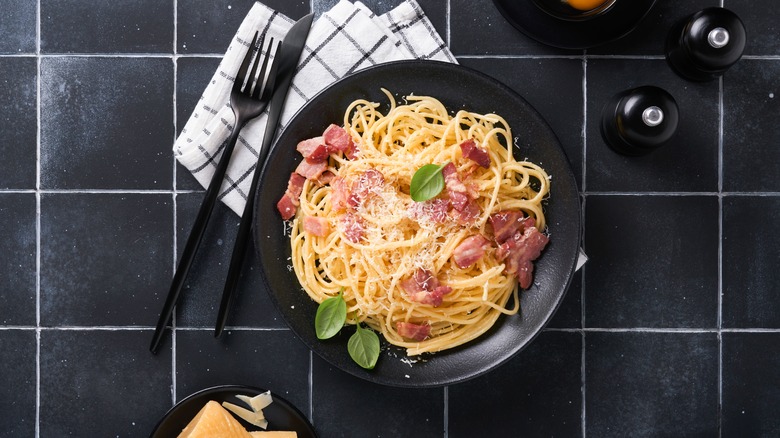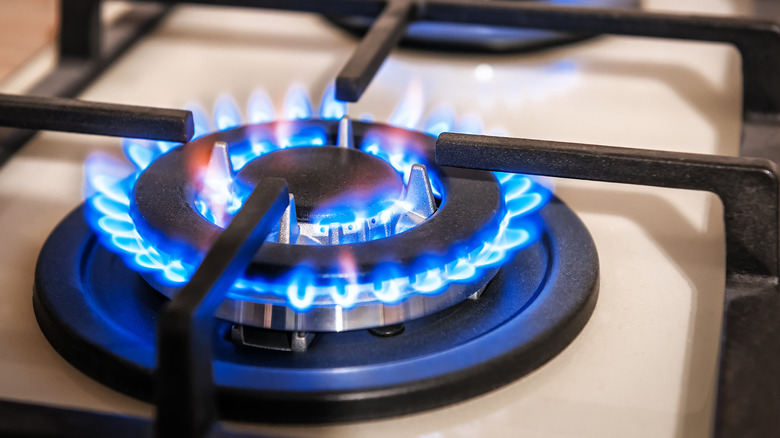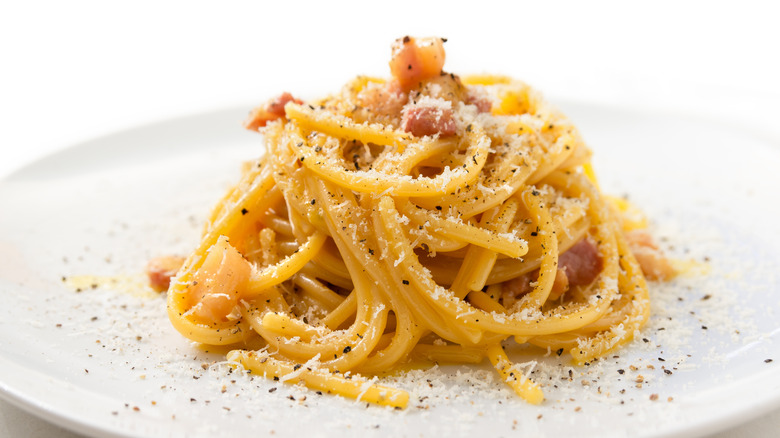Rachael Ray's Crucial Egg Tip To Curb Grainy Carbonara Sauce
When it comes to great pastas, simplicity is key. Just because there aren't a lot of different elements in dishes like a classic tomato sauce, pesto, or carbonara doesn't mean that any of them are lacking in flavor or complexity.
Simplicity doesn't necessarily mean a dish is simple to prepare, though, and there are still lots of mistakes that can ruin a good plate of carbonara. One of the worst things that can happen when making carbonara is for your sauce to go from creamy and smooth to grainy.
Thankfully, TV host and chef Rachael Ray is here to help keep this from happening. Ray says that this is one of her husband's favorite dishes, and he has a lot of requests for how it's served. This includes the non-traditional choice of garlic and more traditional bucatini pasta.
The reason that your sauce can turn grainy in the last stages of cooking is usually related to the temperature of your pan as the sauce is coming together. If the sauce is too warm, then you're basically going to scramble the eggs. Of course, you don't want the sauce to go uncooked, either. To get it just right, you'll need this simple temperature management trick to make the best carbonara every time.
Take it off the heat
Rachael Ray says that the key to the best possible carbonara is to take your pan off the heat before adding the egg and cheese mixture. Following Ray's recipe, you'll want to finish assembling all the separate elements of your carbonara in one pan. That means that you'll start by cooking your guanciale in a pan that's big enough to hold the finished pasta. This is done over a medium heat until the fat is rendered. Meanwhile, the pasta cooks in the water, and the eggs, cheese, and pepper are assembled in another bowl.
When your pasta is finished cooking, you should turn off the heat under your guanciale pan before adding the other elements. The pasta, some pasta water, and the cheese and egg mixture will come together to form that signature creamy sauce in the pan with the guanciale, and your eggs will turn grainy if the heat is still on.
You shouldn't feel like you're eating raw eggs, either. The residual heat in the pan (which can differ depending on the pan used) is usually enough to partially cook the eggs, it just does it with a gentle heat so that it makes more of a custardy sauce similar to French style scrambled eggs rather than allowing whole curds to form.
Never, ever use cream as a shortcut
Following Ray's advice will also encourage you not to cut corners by committing one of the cardinal sins of carbonara — adding cream.
Italian food writer Roberto Serra told Italian publication The Local that anyone who adds cream to carbonara should go to jail. Besides possible legal punishments, adding cream to carbonara also just makes for a lesser version of this classic pasta sauce.
It's understandable why one might reach for a carton of cream to simplify the carbonara cooking process. During high heat cooking cream's high fat content will prevent it from curdling. This would give you the opportunity to have the creamy texture of the eggs and cheese without having to make an effort managing your heat.
This is not only a cardinal sin of carbonara making, but it also won't work as well as you imagine. There's already a lot of fat in your traditional carbonara, and cream's heavy dairy fats will add to that while also altering the dish's texture and mouthfeel. Those dense dairy fats tend to coat your mouth, and will make for a subpar carbonara.


